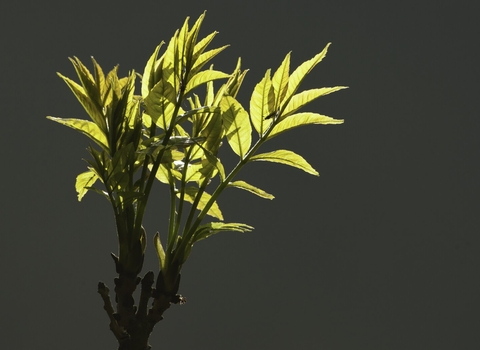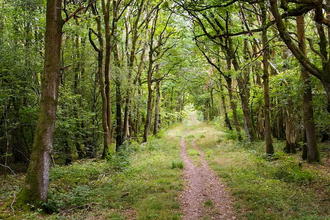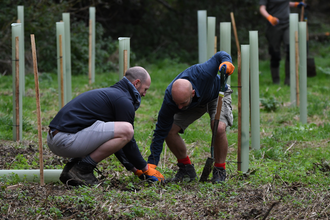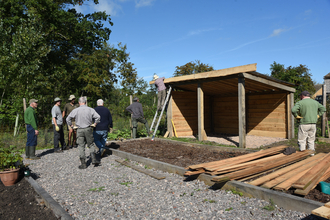What are the symptoms of ash dieback, and has it been found at any GWT reserves?
You can find the answers to our frequently asked questions about ash dieback below.
What are the symptoms of ash dieback
The fungus has two stages to its life cycle - a sexual stage, which helps the fungus spread, and an asexual stage, which is what grows on the tree and causes damage. The fungus blocks water transport in the tree, leading to lesions in the bark, leaf loss and the dieback of the crown.
The main symptoms of ash dieback are:
- Dead branches
- Blackening of leaves which often hang on the tree
- Discoloured stems often with a diamond-shape lesion where a leaf was attached
- Leaves develop dark patches in the summer
- They then wilt and discolour to black. Leaves might shed early
- Dieback of the shoots and leaves is visible in the summer
- Lesions develop where branches meet the trunk. These are often diamond-shaped and dark brown
- Inner bark looks brownish-grey under the lesions
- New growth from previously dormant buds further down the trunk. This is known as epicormic growth and is a common response to stress in trees
Trees may eventually drop limbs, collapse or fall. The symptoms are often easier to spot in mid-late summer, when a healthy ash should be in full leaf. It becomes much harder in autumn, when leaves are naturally changing colour and falling.
Once a tree is infected the disease is usually fatal, either directly, or indirectly by weakening the tree to the point where it succumbs more readily to attacks by other pests or pathogens, such as honey fungus. These secondary pathogens can cause butt or root rot, leading to the tree falling.
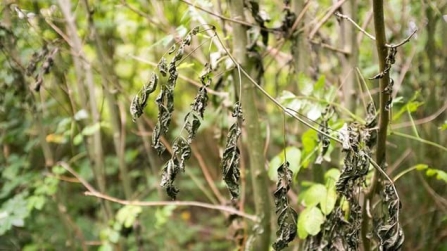
David Mark Alamy Stock Photo
How does it spread?
Ash dieback, also known as 'Chalara' or Chalara ash dieback, was first discovered in Europe in Poland in 1992, and is now found widely across the continent. The first confirmed case in the UK came in 2012, since when it has spread across England and to Scotland, Wales, Northern Ireland, and the Isle of Man.
The disease may spread locally (over tens of miles) by wind dispersal. The reproductive stage of the fungus grows on the previous year's fallen leaves, producing fruiting bodies that release spores between June and September. These spores are dispersed by the wind and settle on the leaves of healthy trees. If a healthy tree receives a high enough dose of spores, it too will become infected.
Over longer distances, the disease may be spread by the movement of infected ash plants.
Further information about ash dieback can be found on the Forestry Research website here.
What impact will ash dieback have?
It's difficult to say how badly Gloucestershire’s ash trees will be affected by the disease. Almost certainly many of our trees will succumb to the disease, but the good news is that (unlike Dutch Elm disease in the 1970’s where UK elm trees lacked any significant genetic variation) ash are known to be very genetically diverse so natural resistance is likely to be the key to the survival of our ash trees.
That being said, it’s thought that we're going to lose up to 95% of our ash trees in the UK. This is going to have a devastating impact on the landscape and the biodiversity of our woodlands, as well as a major loss in connections between habitats as we lose hedges and individual trees outside of woods.
The predicted cost of managing the disease is high. It includes the practical expense of clearing up dead and dying trees, to the loss of its environmental services such as air purification.
The important thing we need to do in the county is to follow the national strategy produced by the Forestry Commission and have trying to find ash trees which appear resistant to the disease as our major action. Landowners shouldn’t start to fell ash trees in the hope that this may slow the spread as this is likely not to help - if you have any questions please do get in touch.
Is there a cure?
There is no cure for ash dieback, but some trees are less susceptible to the disease. Investigating this natural resistance could be the best way to secure the future of the UK's ash trees.
Is there any natural disease tolerance?
There is hope on the horizon. Initial findings suggest that we might have some trees that are tolerant to ash dieback, meaning that the population could eventually recover over time (likely over 50 years).
However, tolerance to the disease is complicated because a number of factors play into it including genetic traits, the health of the tree and the number of ash dieback spores in the atmosphere.
Have any GWT reserves been affected?
Ash is present in most of the wooded nature reserves we care for, but is particularly prevalent in Lower Woods, Siccaridge Wood, Midger Wood and at Snows Farm. Sadly, dieback has been recorded at all of these reserves and has caused extensive damage, killing numerous trees.
How are GWT tackling ash dieback?
Although we aim to carry out as little felling as possible, we have a responsibility keep visitors to our nature reserves safe. Our aim is to leave trees to naturally form standing and fallen deadwood habitats wherever we can.
We focus on ash trees in Chalara stage 3 and 4 (the most severe) and in areas of nature reserves identified as zones 1 and 2 (which means that these areas are adjacent to public footpaths, car parks and roads, and therefore a higher risk to visitors). We work with contractors who respect our desire for the minimum intervention possible. Sadly we cannot wait for the trees to be completely dead as this would be too dangerous for both site visitors and the felling operators.
If we can re-route footpaths that are not public rights of way, we will. Wherever possible we will preserve trees to have the best chance of retaining those that have natural resistance to this disease.
Find out more about what GWT are doing to tackle ash dieback
Why are GWT felling in the summer months?
In a perfect world, all felling work required would be completed before the end of February, however - ash dieback has multiplied more than tenfold the annual tree safety work for most organisations, which unfortunately limits contractor availability. This means that some felling work will need to take place in the spring and summer months as well. All trees are fully inspected for nesting birds and bats by our in-house experts in accordance with protected species legislation.
I'm a landowner and think I have ash dieback on my land, what should I do?
The important thing we need to do in the county is to follow the national strategy produced by the Forestry Commission and try to find ash trees which appear resistant to the disease. Landowners shouldn’t start to fell ash trees in the hope that this may slow the spread as this is likely not to help - if you have any questions please do get in touch by emailing info@gloucestershirewildlifetrust.co.uk.
What can I do to help?
Biosecurity is important to help manage the spread of the disease. Simple steps can all help reduce the risk of spores being spread:
- Clean your shoes before and after visiting a wood
- Avoid taking cuttings or plant material from the countryside
- Wash your car or bike wheels to remove mud or plant matter
Couldn’t find what you’re looking for? You can contact us at info@gloucestershirewildlifetrust.co.uk

